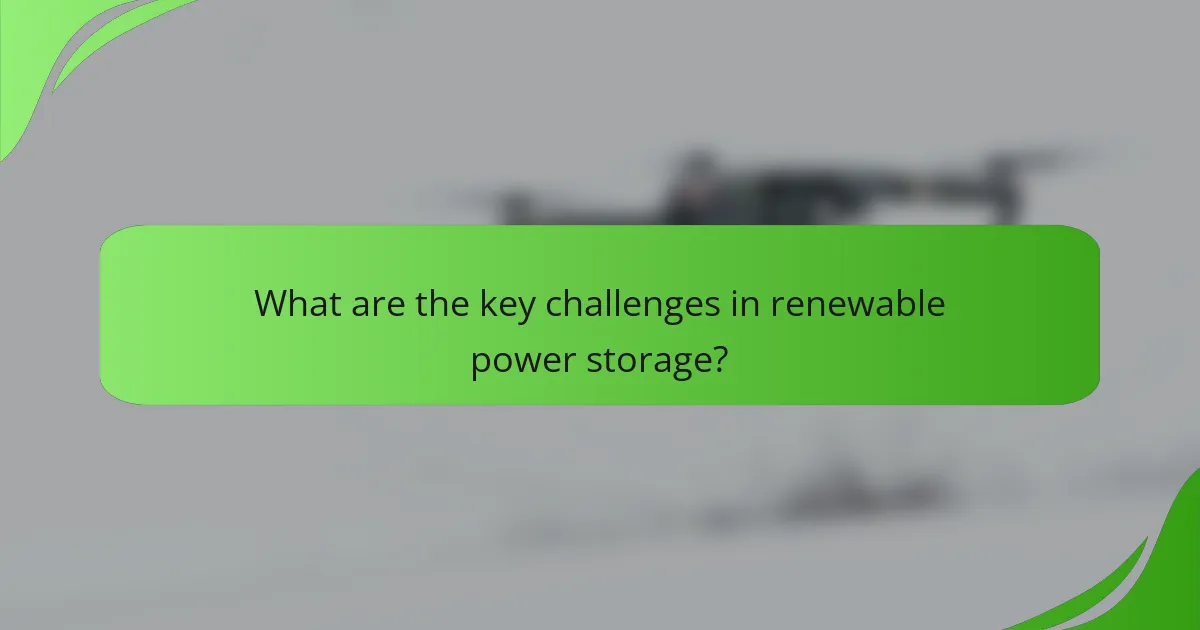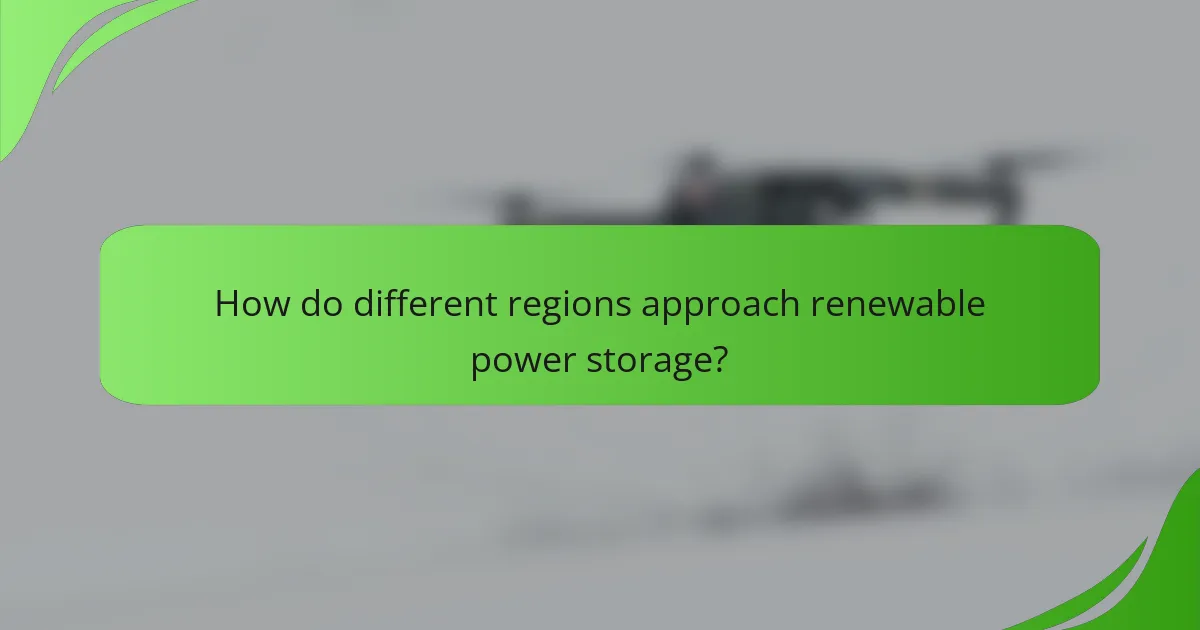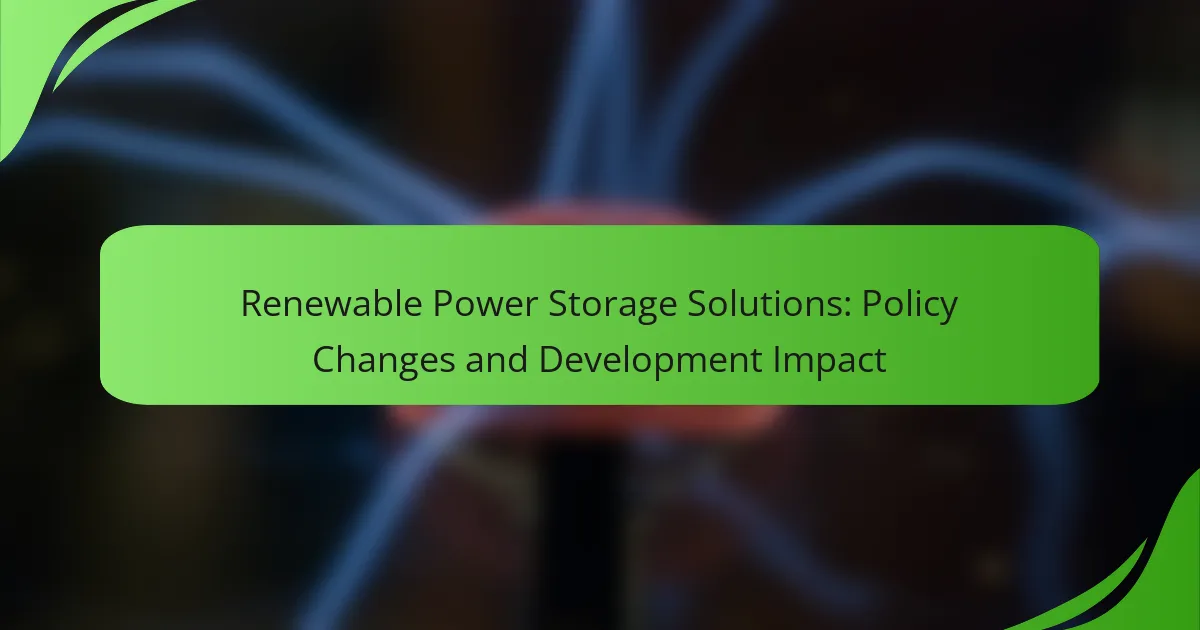Renewable power storage solutions are essential for harnessing energy from renewable sources, ensuring a consistent and reliable energy supply. Technologies such as lithium-ion batteries, pumped hydro storage, and thermal energy storage each offer unique benefits, but their development is heavily influenced by policy changes that can facilitate investment and streamline regulations. Addressing challenges like high initial costs and regulatory hurdles is crucial for advancing these technologies and promoting a sustainable energy future.

What are the leading renewable power storage solutions?
The leading renewable power storage solutions include technologies that effectively store energy generated from renewable sources, allowing for a more stable and reliable energy supply. Key solutions include lithium-ion batteries, pumped hydro storage, flow batteries, compressed air energy storage, and thermal energy storage, each with distinct advantages and applications.
Lithium-ion batteries
Lithium-ion batteries are widely used for energy storage due to their high energy density and efficiency. They are commonly found in electric vehicles and portable electronics, but their application in grid storage is growing rapidly, especially for balancing supply and demand.
When considering lithium-ion batteries, factors such as cycle life, cost, and environmental impact are crucial. Prices have been decreasing, making them more accessible, but recycling and sourcing materials like lithium and cobalt remain challenges.
Pumped hydro storage
Pumped hydro storage is a mature technology that uses two water reservoirs at different elevations to store energy. During low demand, excess electricity is used to pump water uphill; during high demand, the water is released to generate electricity.
This method is highly efficient, with round-trip efficiencies often exceeding 70%. However, it requires significant geographical features and can have environmental impacts, making site selection critical.
Flow batteries
Flow batteries store energy in liquid electrolytes contained in external tanks, allowing for scalable energy storage. They are particularly suited for applications requiring long-duration storage, such as renewable energy integration and grid stabilization.
While flow batteries have a longer lifespan and can be easily scaled, they currently face higher upfront costs compared to lithium-ion batteries. Ongoing research is focused on improving their efficiency and reducing costs.
Compressed air energy storage
Compressed air energy storage (CAES) involves storing energy by compressing air in underground caverns or tanks. When energy is needed, the compressed air is heated and expanded to drive turbines and generate electricity.
CAES can provide large-scale energy storage and is particularly effective for balancing intermittent renewable sources. However, its efficiency can be lower than other technologies, and it requires specific geological formations for implementation.
Thermal energy storage
Thermal energy storage systems store energy in the form of heat, often using materials like water, molten salt, or concrete. This method is commonly used in concentrated solar power plants to provide energy even when sunlight is not available.
Thermal storage can be cost-effective and has a long lifespan. However, it is typically limited to specific applications and may not be suitable for all energy storage needs, particularly in regions without significant thermal resources.

How do policy changes impact renewable power storage development?
Policy changes significantly influence the development of renewable power storage by shaping the financial and regulatory landscape. Effective policies can enhance technology adoption, streamline regulatory processes, and attract investment, ultimately accelerating the transition to sustainable energy solutions.
Incentives for technology adoption
Government incentives play a crucial role in promoting the adoption of renewable power storage technologies. These can include tax credits, grants, and rebates that lower the initial costs for businesses and consumers. For instance, in the United States, the Investment Tax Credit (ITC) allows for a significant percentage of the installation costs to be deducted from federal taxes.
Additionally, performance-based incentives reward users for the actual energy savings achieved through storage systems. Such measures can drive faster implementation and innovation in storage technologies, making them more accessible to a wider audience.
Regulatory frameworks for energy storage
Robust regulatory frameworks are essential for the effective integration of renewable power storage into the energy grid. Clear regulations define the roles of various stakeholders, including utilities, developers, and consumers, ensuring that everyone understands their responsibilities. For example, some regions have established specific interconnection standards that facilitate the connection of storage systems to the grid.
Moreover, regulations can dictate the operational parameters for energy storage, such as how much energy can be stored and for how long. This clarity helps to optimize the use of storage systems and enhances grid reliability.
Impact on investment and funding
Policy changes can significantly affect investment and funding in renewable power storage projects. Favorable policies often attract private investment by reducing perceived risks and improving potential returns. For example, countries with clear renewable energy targets and supportive legislation tend to see higher levels of venture capital and private equity flowing into storage technologies.
Conversely, uncertainty in policy can deter investment, leading to delays in project development. Investors typically seek stable regulatory environments that provide long-term visibility, which is essential for financing large-scale storage initiatives. Therefore, maintaining consistent and supportive policies is key to fostering a thriving renewable power storage market.

What are the key challenges in renewable power storage?
The key challenges in renewable power storage include high initial costs, limited lifespan of storage systems, and regulatory hurdles. These factors can significantly impact the feasibility and adoption of renewable energy solutions.
High initial costs
One of the most significant barriers to renewable power storage is the high initial costs associated with purchasing and installing storage systems. Technologies such as lithium-ion batteries can require substantial upfront investment, often ranging from thousands to tens of thousands of dollars depending on capacity and application.
To mitigate these costs, stakeholders can explore financing options, government incentives, or partnerships that may help distribute the financial burden. Additionally, investing in larger-scale systems can sometimes lead to economies of scale, reducing the per-unit cost of energy storage.
Limited lifespan of storage systems
Storage systems, particularly batteries, have a limited lifespan that can affect their long-term viability. Most lithium-ion batteries, for example, typically last between 5 to 15 years, depending on usage patterns and environmental conditions. This limited lifespan necessitates planning for replacement and disposal, which can add to overall costs.
To maximize the lifespan of storage systems, users should implement proper maintenance practices and monitor usage closely. Choosing systems with longer warranties or those designed for high cycle life can also provide better long-term value.
Regulatory hurdles
Regulatory hurdles can complicate the deployment of renewable power storage solutions. Different regions have varying regulations regarding energy storage, grid integration, and safety standards, which can create challenges for developers and investors. Compliance with these regulations often requires additional time and resources.
To navigate these hurdles effectively, stakeholders should stay informed about local regulations and engage with policymakers to advocate for supportive frameworks. Collaborating with industry associations can also provide insights into best practices and emerging regulatory trends that may impact storage solutions.

How is the renewable power storage market evolving in the United States?
The renewable power storage market in the United States is rapidly advancing due to technological innovations, regulatory support, and increasing demand for clean energy solutions. This evolution is characterized by significant investments in battery technologies, state-level initiatives promoting renewable energy, and collaborations between utilities and technology firms.
Growth in battery manufacturing
The growth in battery manufacturing is a key driver of the renewable power storage market. Companies are scaling up production to meet the rising demand for energy storage systems, particularly lithium-ion batteries, which are favored for their efficiency and cost-effectiveness. Many manufacturers are establishing facilities across the U.S., leading to job creation and economic growth.
As battery technology improves, costs are expected to decline, making energy storage more accessible for residential and commercial users. This trend is supported by government incentives and investments aimed at enhancing domestic manufacturing capabilities.
State-level initiatives
State-level initiatives play a crucial role in advancing renewable power storage solutions. Many states have implemented policies that encourage the adoption of energy storage technologies, such as tax credits, rebates, and grants. For instance, California has set ambitious goals for energy storage deployment, aiming for several gigawatts of capacity by the mid-2020s.
These initiatives not only promote the integration of renewable energy sources but also enhance grid reliability and resilience. States are increasingly recognizing the importance of energy storage in achieving their climate goals and reducing greenhouse gas emissions.
Partnerships between utilities and tech companies
Partnerships between utilities and technology companies are fostering innovation in the renewable power storage sector. Utilities are collaborating with tech firms to develop advanced storage solutions that optimize energy management and enhance grid performance. These partnerships often focus on integrating artificial intelligence and data analytics to improve efficiency.
Such collaborations can lead to pilot projects that test new storage technologies in real-world scenarios, providing valuable insights and accelerating deployment. As utilities seek to modernize their infrastructure, these partnerships are essential for driving the transition to a more sustainable energy landscape.

What are the benefits of renewable power storage?
Renewable power storage offers several advantages, including enhanced grid stability, improved integration of renewable energy sources, and potential reductions in energy costs. These benefits contribute to a more sustainable and resilient energy system.
Grid stability and reliability
Renewable power storage systems, such as batteries and pumped hydro storage, help maintain grid stability by balancing supply and demand. They can quickly release stored energy during peak demand periods, ensuring that the grid remains reliable and reducing the risk of blackouts.
By providing ancillary services like frequency regulation and voltage support, storage solutions enhance the overall reliability of the electrical grid. This is particularly important as more intermittent renewable sources, like solar and wind, are integrated into the energy mix.
Integration of renewable energy sources
Energy storage facilitates the integration of renewable sources by smoothing out fluctuations in energy generation. For instance, batteries can store excess solar energy generated during the day for use at night or during cloudy periods, effectively bridging the gap between generation and consumption.
Moreover, storage systems can help manage the variability of wind energy, allowing for a more consistent supply. This capability is essential for achieving higher penetration levels of renewables, which is often a goal of national energy policies.
Reduction of energy costs
Implementing renewable power storage can lead to significant reductions in energy costs over time. By storing energy when prices are low and discharging it when prices are high, consumers can take advantage of price arbitrage, ultimately lowering their overall energy bills.
Additionally, as storage technologies continue to advance and scale, the costs associated with these systems are expected to decline. This trend will further enhance the economic viability of renewable energy projects, making them more attractive for both residential and commercial users.

How do different regions approach renewable power storage?
Regions vary significantly in their approaches to renewable power storage, influenced by local policies, resource availability, and technological advancements. Strategies often include a mix of regulatory frameworks, financial incentives, and investment in infrastructure to enhance energy storage capabilities.
California’s energy storage policies
California has implemented aggressive energy storage policies to support its ambitious renewable energy goals. The state aims to achieve 100% clean energy by 2045, which necessitates a robust energy storage system to manage intermittent renewable sources like solar and wind.
The California Public Utilities Commission (CPUC) has set specific targets for energy storage capacity, requiring utilities to procure a total of 1,325 megawatts of storage by 2024. This policy framework encourages the development of various storage technologies, including lithium-ion batteries and pumped hydro storage.
Additionally, California offers financial incentives such as the Self-Generation Incentive Program (SGIP), which provides rebates for energy storage systems installed by residential and commercial customers. These initiatives help lower the upfront costs and promote wider adoption of energy storage solutions.
